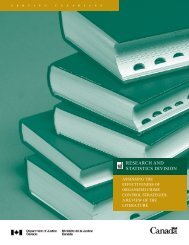National Threat Assessment 2008. Organised Crime - Politie
National Threat Assessment 2008. Organised Crime - Politie
National Threat Assessment 2008. Organised Crime - Politie
You also want an ePaper? Increase the reach of your titles
YUMPU automatically turns print PDFs into web optimized ePapers that Google loves.
moving from the Netherlands to Canada, Russia and other countries.<br />
The market for illegal hard copies is shrinking. Anyone can download these<br />
days and soft copies are cheaper. The approach under private law also appears<br />
to be having an effect.<br />
5.4.7 Conclusion<br />
ICT piracy was designated as a threat in NTA 2004. At the time it was assumed<br />
that the number of illegal copies with links to organised crime (hard copies)<br />
would exceed those of private amateurs (soft copies). This situation has changed<br />
in the meantime. Hard copy sales are constantly falling, whilst the number of<br />
soft copies is increasing. It also turns out that there is hardly any production of<br />
illegal hard copies in the Netherlands. The damage to the music and film<br />
industry is caused by criminal organisations abroad. Due to the loss of popularity,<br />
pirates can no longer earn as much from hard copies and the damage has<br />
therefore also decreased.<br />
From a financial point of view, hosting file sharing sites is still appealing, however,<br />
but because of the advertising income rather than the soft copies. In the<br />
Netherlands action is currently being taken against these sites, as a result of which<br />
the Netherlands has become less attractive as a country for establishing such sites.<br />
The expectation is that ICT piracy will be no specific threat in the next four years.<br />
5.5 Phishing<br />
5.5.1 Introduction and scope<br />
Phishing was investigated as part of the NTA 2006 follow-up study and qualified<br />
as a conditional threat. The insights from that follow-up study, plus recent<br />
observations, formed the basis for the section on phishing in the reassessment<br />
project for the present NTA.<br />
Phishing is described as ‘using digital activities to unlawfully gain possession of<br />
and/or use the identity details of an Internet user, in whole or in part, with the<br />
aim of committing a criminal offence where the Internet user will be the victim’.<br />
5.5.2 General context<br />
Broadly speaking, there are three types of phishing: classic phishing, pharming<br />
and spy phishing. In the (now) classic form of phishing an email is sent to<br />
Internet users. The email appears to come from a financial institution or<br />
company. The aim is to convince recipients to click on a link in the email that<br />
chapter 5 – Criminal modus operandi<br />
195








